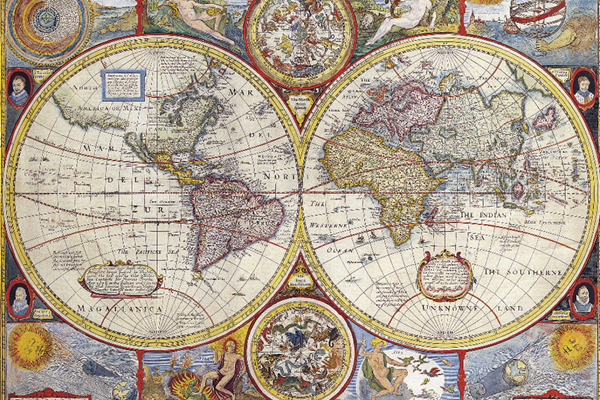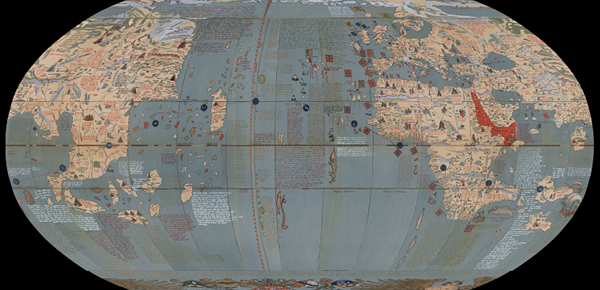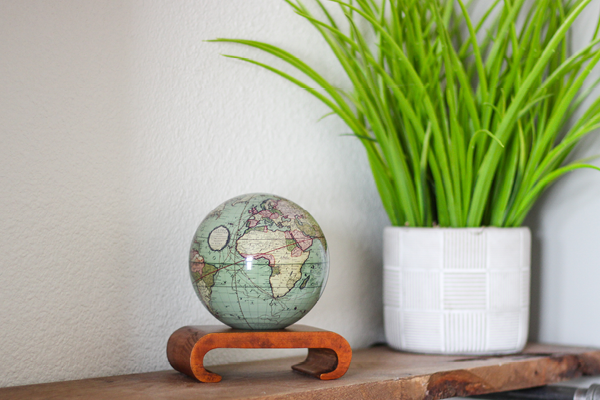Have you ever wondered how the world went from using flat maps to globes? While there are romantic tales of Christopher Columbus sailing toward the New World, intent on proving the Earth was a sphere while searching out new routes to the Indies, this isn’t the full story. Globes have actually been around much longer, although they were not widely utilized until the Age of Exploration in the 15th and 16th centuries. Meanwhile, flat maps have been around even longer – since the Babylonian times.
The First Flat Maps to Globes

Since almost the beginning of society, humans have had a desire to map out the world around them. Early maps not only showed geographic locations, but they were also heavily influenced by belief systems and religions of the time. Religiously important cities, for instance, were often depicted as being the center of the world.
Before any of the maps we know today, the Babylonians created the first known maps of the world on clay tablets. The oldest known map was created in around 600 B.C. and depicts Babylon and the nearby Euphrates river as large squares in the center, with round shapes on the outskirts to represents Assyria and Susa. Additional triangular shapes are shown even farther from the central area to represent unknown lands and mysterious societies. These were given vague names such as “beyond the flight of birds.” These lands were said to be inhabited by mythological creatures and dangerous beasts, indicating that cartographers combined both geographical concepts with legends and beliefs of the time.
Cartography from the Greeks was perhaps the most sophisticated of the ancient worlds. The first globe is thought to have been created by Crates of Mallus, who was a Greek philosopher from what is now modern day Turkey. There are no surviving copies of his globe, but later writers described it as being spherical in shape. Even earlier than that, in the 6th century B.C.E., Pythagoras predicted that the world was actually round in shape. His theories were later proved to be true by Aristotle in his studies of astronomy.
The First Surviving Globes

Although Christopher Columbus cannot be credited with determining that the Earth was round (since the Greeks determined that hundreds of years prior), the first surviving globe was created in the 15th century as he was gearing up for his voyage to the New World. It was created by Martin Behaim, a German geographer and explorer of the time. His globe (pictured above) was referred to as Erdapfel, which translates to “Earth Apple.” The globe still exists today, but is kept protected by German authorities. The globe was created using current understanding of the Earth at the time, and doesn’t include the continents North or South America, Antarctica or Australia.
Only a few years later, another of the oldest surviving globes was created – what is now known as the Hunter-Lenox globe. Created in 1510, it was owned by Richard Morris Hunt, who reportedly bought it in France, and brought it to America in 1855. He later gave it to James Lenox, a bibliophile whose entire collection was eventually given to the New York Library Rare Book Division, where it can be seen by patrons willing to register in advance and schedule an appointment. While more accurate than the Erdapfel, as it contains South America as a continent, it was still off on a few key details. Namely, it depicts the North American continent as a series of scattered islands.
On the globe, the words “Here be dragons” are inscribed as a warning that bad things lurked beneath the waters of the oceans.
The exact origins of the Hunter-Lennox are unknown, though it has been linked to an ostrich egg globe created in 1504 – the only other known globe to include the phrase “here be dragons.” It is believed the globe might be a cast of the egg-sketch globe. Others speculate it might be credited to Leonardo DaVinci, as the artwork is very similar to his style and that of his acquaintances. Many speculate that he was commissioned by a wealthy family in Italy to create the map, as many rich families of the time would have owned ostriches.
Wherever it came from, both the Hunter-Lennox and the Erdapfel prove that scientists of the time were aware of the Earth’s true shape long before Columbus set sail to the New World.
Why Globes are Superior to Flat Maps

Have you ever wondered why a globe is superior to a flat map? The reasons should be obvious, as the Earth is a sphere, and so is a globe. This leads to a much less distorted view of the Earth’s surfaces, and allows for far more useful measurements. Early globe-makers likely created the first globes in order to more accurately depict land masses and their distances as they learned more about the Earth during the Age of Exploration in the 15th and 16th centuries. Exploration and claiming new lands was highly important for societies at the time, and having an accurate way to gauge the Earth’s surface would have been of the utmost importance.
Today, globes are still in use and are still an important aspect of our lives. Though we now have computerized maps and satellite navigation systems, a conventional world globe is still one of the most highly effective means of teaching geography to children and new enthusiasts. They are easily accessible and available in numerous sizes. They’re also lightweight, allowing students to easily turn and view various land masses as the globe spins, giving a three-dimensional view of the Earth and all of its features.
Today’s globes are also a simple, elegant, and easy way to appreciate the beauty of the Earth. Decorative globes are a unique décor option that can provide a realistic view of the Earth from space, or celebrate the history of cartography, astronomy, and world exploration.

